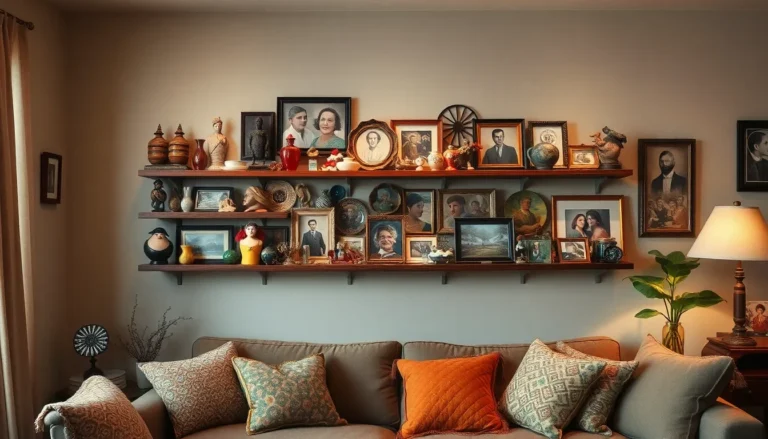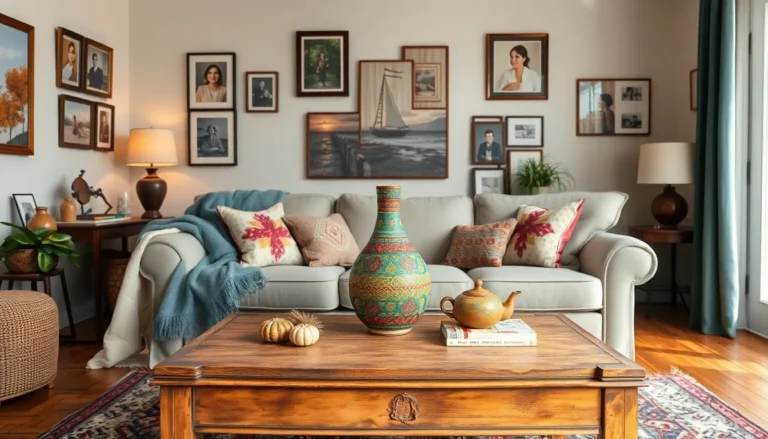Transforming a bedroom into a cozy retreat is easier than one might think. The secret? Choosing the right hues. Imagine stepping into a space that wraps you in warmth and relaxation, like a well-loved blanket on a chilly night. Inviting bedroom hues can do just that, making even the grumpiest morning bearable.
From soft pastels that whisper sweet nothings to bold jewel tones that scream, “Welcome home!” the color palette you choose can set the mood for your sanctuary. It’s not just about aesthetics; it’s about creating an atmosphere that invites peace and tranquility. So why settle for boring whites when a splash of color can turn your bedroom into a dreamy escape? Embrace the power of inviting hues and watch your space transform into a haven of comfort and style.
Table of Contents
ToggleUnderstanding Inviting Bedroom Hues
Selecting inviting bedroom hues involves recognizing how colors influence mood and comfort. Color choice creates an atmosphere of warmth, helping to transform a bedroom into a serene sanctuary.
The Psychology of Color
Colors evoke emotions and affect well-being. Soft blues promote tranquility while warm earth tones create a sense of security. Psychological studies indicate that certain shades can reduce stress levels, establishing a calming vibe in sleep spaces. Using colors like lavender or pale green fosters relaxation, making it easier to unwind. Conversely, vibrant hues stimulate energy and creativity, which might not be ideal for a restful environment. Choosing subtle pastels can bring serenity, allowing for a peaceful retreat.
The Impact of Light
Natural light plays a critical role in how colors appear in a bedroom. Morning sunlight enhances soft hues, while artificial light can change perceptions of shades. Lighting affects color temperature, influencing the mood of a space. Warm light intensifies rich colors, making them more inviting. In contrast, cool light can make colors seem stark, affecting one’s sense of comfort. Incorporating layered lighting solutions can create depth, bringing inviting colors to life throughout the day. Adjusting curtains or window treatments also maximizes natural light exposure, enhancing the overall ambiance.
Popular Inviting Bedroom Hues

Selecting inviting hues transforms a bedroom into a serene haven. Many color options create an atmosphere of comfort and tranquility.
Warm Colors
Warm colors such as red, orange, and yellow evoke feelings of coziness and comfort. These hues create a welcoming environment that encourages relaxation. Rich terracotta and soft peach can generate warmth without overwhelming the senses. Adding accents in warm colors further enhances the space, creating a dynamic and stimulating atmosphere. Incorporating textures like soft fabrics or patterned cushions in these tones can amplify the inviting feel. Warm colors work best in rooms with ample natural light, illuminating their comforting qualities.
Cool Colors
Cool colors like blue, green, and lavender foster tranquility and relaxation. Light shades of blue promote calmness, while muted greens contribute to a refreshing ambiance. Lavender offers a soft, soothing effect that encourages restful sleep. Choosing cool colors for bedroom walls or bedding creates an inviting retreat that enhances serenity. These hues pair beautifully with soft white or neutral accents, providing a balanced contrast. In low-light conditions, cool colors can still maintain their calming essence, making them an ideal choice for creating a peaceful nighttime atmosphere.
Choosing the Right Hues for Your Space
Selecting the right hues significantly impacts the comfort level in a bedroom. Considerations rooted in room size and personal aesthetics guide color choices effectively.
Consider Your Room Size
Room size plays a crucial role in color selection. Smaller bedrooms benefit from light colors like soft white or pastel shades, creating an illusion of spaciousness. Light shades reflect more natural light, making the area feel open and airy. Larger rooms offer the luxury of darker hues, like deep blue or rich burgundy. These colors can create a cozy, intimate space. Additionally, contrast is key; introducing darker colors on an accent wall balances larger areas and adds depth. Using varying paint finishes can enhance texture, making the space visually appealing.
Aligning with Personal Style
Personal style significantly influences color choices. Individuals should reflect their preferences through hues that resonate positively. For example, a minimalist aesthetic thrives on neutral tones such as greys and whites. Meanwhile, a bohemian style might embrace vibrant oranges and intricate patterns. It’s beneficial to gather samples and visualize how colors interact with existing furnishings and decor. Exploring mood boards can also facilitate a clearer vision of the desired ambiance. Ultimately, choosing colors that evoke joy and comfort fosters a welcoming sanctuary. Prioritizing personal connection with specific shades results in a harmonious space that truly represents individual taste.
Tips for Incorporating Inviting Bedroom Hues
Incorporating inviting hues into a bedroom involves strategic choices in color application. Selecting the right techniques and accessories enhances the overall atmosphere.
Paint Techniques
Experimenting with different paint techniques can dramatically change a bedroom’s look. For an added sense of depth, consider using a sponge or rag rolling technique, which creates a textured appearance. For a subtle effect, try ombre painting, where colors gradually blend from dark to light. Accent walls often introduce a pop of color, inviting a focal point without overwhelming the space. Incorporate stencils or patterns for a playful touch; this adds personality while maintaining a cozy feel. Techniques like color washing can soften transitions between hues, providing warmth without harsh lines.
Accents and Accessories
Choosing the right accents and accessories complements inviting hues in a bedroom. Use throw pillows and blankets in coordinating colors, adding layers of comfort. Artwork that features inviting shades enhances the overall theme while drawing the eye. Light fixtures in warm tones, particularly those made of natural materials, can soften the ambiance significantly. Opt for curtains in soothing colors that filter natural light gently, creating a serene atmosphere. Finally, decorative items like vases or books can showcase vibrant colors, enhancing the inviting feel without dominating the space.
Creating an inviting bedroom starts with the right color choices. By embracing warm and cool hues that resonate with personal style, individuals can transform their spaces into serene retreats. The interplay of colors not only enhances aesthetics but also significantly impacts mood and well-being.
Whether opting for soft pastels or bold jewel tones, the goal remains the same: to foster an environment that promotes relaxation and comfort. With thoughtful selection and strategic application of colors, anyone can achieve a cozy sanctuary that reflects their unique taste and invites tranquility into their lives.



